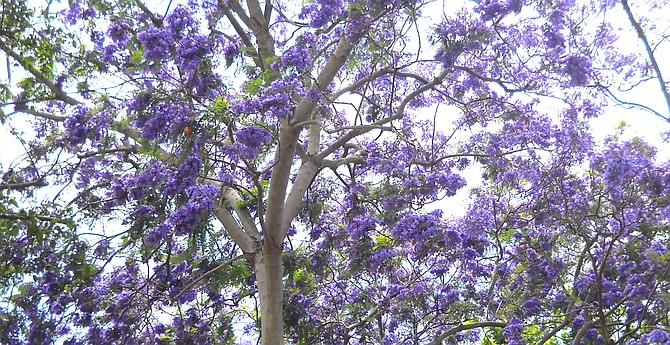 Facebook
Facebook
 X
X
 Instagram
Instagram
 TikTok
TikTok
 Youtube
Youtube

Blue-Blossoming Jacaranda Trees have already produced a first wave of color along the streets of San Diego. By early or mid-May, warm weather permitting, this Brazilian import could put on a dazzling show. The larger jacarandas, which in full bloom are leafless, or nearly so, display myriads of delicate, trumpet-shaped blossoms — a lavender haze as seen from afar. Jacarandas are commonly used as landscaping in parks and on most college campuses. Nice rows of jacarandas grace several streets downtown, Rosecrans Boulevard in Point Loma, 25th Street in Golden Hill, and Mission Village Drive above Qualcomm Stadium.
Monkey-Flowers of various species are putting on an excellent display this month around San Diego. Look for these low, shrublike plants with tubular yellow, orange, or red flowers wherever native vegetation clothes the landscape — from the coastal bluffs to the lower slopes of the mountains. As you drive Interstates 8 or 805 near Mission Valley, look for the rust tint these flowers give to the steep hillsides. On the terraces just above San Onofre State Beach, you can usually see springtime monkeyflower blossoms of every intermediate shade from yellow to red.
Bracken Ferns are rising on the higher mountains of San Diego County, their bright green, unfolding fronds (called "fiddleheads") pushing up through the russet remains of last year's growth. Look for waist-high bracken fern along the 7 creeks and hollows of the Palomar, Cuyamaca, and Laguna mountains.
Desert Agaves, or century plants, are sending up their asparagus-like flower stalks on rocky hillsides throughout much of the Anza-Borrego Desert. On warm, sunny days the stalks may grow almost one foot per day (fast enough for you to notice the sharp leaf tips at the bud actually separating from one another). After the stalk reaches a height of 10-20 feet, clusters of waxy, yellow flowers appear, ready for pollination by bees and other insects. After blooming, the fleshy, dagger-like leaves at the base of the plant die (after a life of 10 or 20 years, not a century) and the stalk, bearing a crop of seeds, dries up as well.
Arcturus is the brightest star high in the east these evenings. Spica shines lower right of it by about three fists at arm's length. To the right of Spica by half that distance is the distinctive four-star constellation of Corvus, the springtime Crow.
The above comes from the Outdoors listings in the Reader compiled by Jerry Schad, author of Afoot & Afield in San Diego County. Schad died in 2011. Planet information from SkyandTelescope.org.


Blue-Blossoming Jacaranda Trees have already produced a first wave of color along the streets of San Diego. By early or mid-May, warm weather permitting, this Brazilian import could put on a dazzling show. The larger jacarandas, which in full bloom are leafless, or nearly so, display myriads of delicate, trumpet-shaped blossoms — a lavender haze as seen from afar. Jacarandas are commonly used as landscaping in parks and on most college campuses. Nice rows of jacarandas grace several streets downtown, Rosecrans Boulevard in Point Loma, 25th Street in Golden Hill, and Mission Village Drive above Qualcomm Stadium.
Monkey-Flowers of various species are putting on an excellent display this month around San Diego. Look for these low, shrublike plants with tubular yellow, orange, or red flowers wherever native vegetation clothes the landscape — from the coastal bluffs to the lower slopes of the mountains. As you drive Interstates 8 or 805 near Mission Valley, look for the rust tint these flowers give to the steep hillsides. On the terraces just above San Onofre State Beach, you can usually see springtime monkeyflower blossoms of every intermediate shade from yellow to red.
Bracken Ferns are rising on the higher mountains of San Diego County, their bright green, unfolding fronds (called "fiddleheads") pushing up through the russet remains of last year's growth. Look for waist-high bracken fern along the 7 creeks and hollows of the Palomar, Cuyamaca, and Laguna mountains.
Desert Agaves, or century plants, are sending up their asparagus-like flower stalks on rocky hillsides throughout much of the Anza-Borrego Desert. On warm, sunny days the stalks may grow almost one foot per day (fast enough for you to notice the sharp leaf tips at the bud actually separating from one another). After the stalk reaches a height of 10-20 feet, clusters of waxy, yellow flowers appear, ready for pollination by bees and other insects. After blooming, the fleshy, dagger-like leaves at the base of the plant die (after a life of 10 or 20 years, not a century) and the stalk, bearing a crop of seeds, dries up as well.
Arcturus is the brightest star high in the east these evenings. Spica shines lower right of it by about three fists at arm's length. To the right of Spica by half that distance is the distinctive four-star constellation of Corvus, the springtime Crow.
The above comes from the Outdoors listings in the Reader compiled by Jerry Schad, author of Afoot & Afield in San Diego County. Schad died in 2011. Planet information from SkyandTelescope.org.
Comments